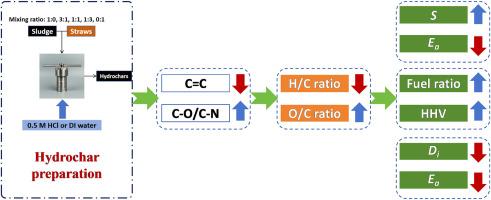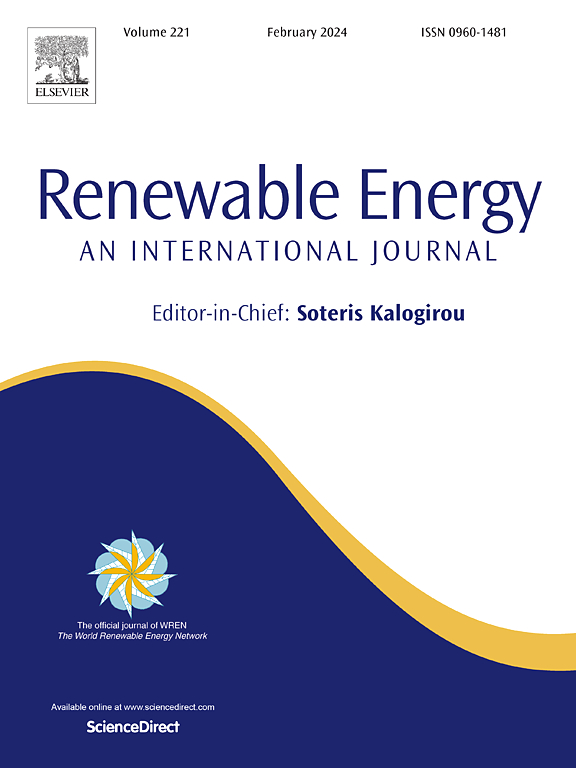Acid-catalyzed co-hydrothermal carbonization of sewage sludge and mixed straws to produce high-quality solid fuel
IF 9
1区 工程技术
Q1 ENERGY & FUELS
引用次数: 0
Abstract
To improve the hydrochar fuel quality, acid-catalyzed co-hydrothermal carbonization (co-HTC) of sewage sludge with mixed straws were performed at 220 °C. The impacts of mixing ratio (1:0, 1:3, 1:1, 3:1, and 0:1) and solvent (0.5 M HCl or dionized water) on hydrochar quality were assessed. The acid-catalyzed co-HTC increased the higher heating value and fuel ratio of the hydrochar by decreasing the H/C atomic ratio and increasing the O/C atomic ratio. The devolatilization index (Di) and combustibility index (S) of the hydrochar from co-HTC at a sludge-to-straws dry-mass ratio of 1:1 reached 64.6 and 26.8 (10−8 wt%2 min−2 K−3), respectively, which was over three times and 2.5 times that from sludge. Di was affected by the surface functional groups, whereas S was related to the chemical composition and fuel properties. Less energy is required after acid-catalyzed co-HTC for both pyrolysis and combustion processes, because of the increase in O/C atomic ratio. This study not only demonstrates the yields and quality of the hydrochar in response to the variation of mixing ratio and solvent, but also uncovers the relationship between hydrochar quality and pyrolysis/combustion performance, thereby providing valuable information for optimizing the acid-catalyzed co-HTC process.

酸催化污水污泥和混合秸秆的共水热碳化以生产优质固体燃料
为了提高水炭燃料的质量,在220 °C下对污水污泥和混合秸秆进行了酸催化共热碳化(co-HTC)。评估了混合比例(1:0、1:3、1:1、3:1 和 0:1)和溶剂(0.5 M HCl 或电离水)对水炭质量的影响。酸催化共 HTC 通过降低 H/C 原子比和提高 O/C 原子比,提高了水碳的热值和燃料比。在污泥与秸秆干物质比为 1:1 的条件下,共热催化技术产生的水炭的脱灰指数(Di)和可燃指数(S)分别达到 64.6 和 26.8(10-8 wt%2 min-2 K-3),分别是污泥的 3 倍和 2.5 倍以上。Di 受表面官能团的影响,而 S 则与化学成分和燃料特性有关。由于 O/C 原子比的增加,酸催化共 HTC 后热解和燃烧过程所需的能量都减少了。这项研究不仅证明了混合比和溶剂变化对水炭产量和质量的影响,还揭示了水炭质量与热解/燃烧性能之间的关系,从而为优化酸催化共热碳化工艺提供了有价值的信息。
本文章由计算机程序翻译,如有差异,请以英文原文为准。
求助全文
约1分钟内获得全文
求助全文
来源期刊

Renewable Energy
工程技术-能源与燃料
CiteScore
18.40
自引率
9.20%
发文量
1955
审稿时长
6.6 months
期刊介绍:
Renewable Energy journal is dedicated to advancing knowledge and disseminating insights on various topics and technologies within renewable energy systems and components. Our mission is to support researchers, engineers, economists, manufacturers, NGOs, associations, and societies in staying updated on new developments in their respective fields and applying alternative energy solutions to current practices.
As an international, multidisciplinary journal in renewable energy engineering and research, we strive to be a premier peer-reviewed platform and a trusted source of original research and reviews in the field of renewable energy. Join us in our endeavor to drive innovation and progress in sustainable energy solutions.
 求助内容:
求助内容: 应助结果提醒方式:
应助结果提醒方式:


